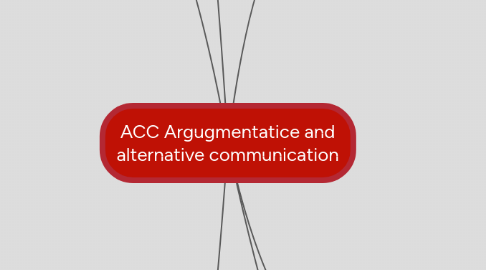
1. Common Causes of Communication Needs
1.1. Intellectual disability
1.1.1. significant limitations in both intellectual functioning and adaptive behavior as ecpressed in conceptual, social, and practical adaptive skills.
1.2. Autism spectrum disorders
1.2.1. a group of developmental disorders characterized by impaired social interactions; difficulty with verbal and nonverbal communication and unusual, repetitive or several limited activities and interests
1.3. Traumatic brain injury
1.3.1. is an acquired injury to the brain caused by a tramatic event
1.4. Stroke
1.4.1. occurs when the blood supply to part of the brain is interrupted or when a blood vessel in the brain ruptures
1.5. Degenerative Diseases
1.5.1. Amyotrophic lateral sclerosis: ALS, unintelligible speech, poor respiratory functioning, resulting in mechanical ventilation
1.5.2. Parkinson's disease: slwly progressive disease of the basal ganglia in the central nervous sytem, dysarthria, motor speech disorder
1.5.3. Dementia: can affect communication, less intellectial functioning resulting in disruptions to daily activities
1.6. Cerebral Palsy
1.6.1. a neuromotor impairment resulting from trauma or damage to the developing child before, during or soon after birth
1.7. Childhood Apraxia of speech
1.7.1. a speech disorder characterized by the inability to control ther purposeful speech movements and sequences of speech movements
2. Communication Needs
2.1. Needs and Wants
2.2. Information Transfer
2.2.1. give and recieve information
2.3. Social closeness
2.3.1. people interact and like to communicate with one another
2.4. Social Etiquette
2.4.1. being polite and conforming to the social conventions of one's culture
3. Assessment
3.1. Comprehensice AAC assessment: after a referral is made occurs when a person communication may not being functuning normally
3.1.1. Oppurtunity barriers: imposed by other people d prevent an individual's participation in communication activities
3.1.2. access barriers: prevent communication but come from the person their attitudes, capitabilities, and resources are not adequate
4. Hybird display
4.1. use a combination of display types
5. Multimodal combination to meet communication goals
5.1. CCN: impairments that prevent communication is conventional ways
5.2. Communication competecne: requires significant time and effort, they are intrinsic and extrinsic
5.2.1. emerging communication: have no reliable method of symbolic expression and are limited to onsymbolic methods of communicating, facial expressions
5.2.2. context-dependent communicaiton: have reliable symbolic communication but communicate in only a few contexts or with only a few partners
5.2.3. independent communicaiton: usually literate and interact with both familiar ans unfamiliar communication partners
5.2.3.1. communication enviroments: different settings
5.3. Communication roles: when an individual with complex communication needs can participate in any desired aspect of society
5.3.1. social roles: the roles each person has in society friend, consumer, student, employee and employer, etc
6. ACC System
6.1. SYMBOL
6.1.1. Stands for something else
6.1.1.1. Static: do not require movement or change to understand their meaning
6.1.1.2. Dynamic: symboles require movement or change to understand their meaning
6.1.1.3. Iconicity: the degree to which symbols visually resemble what they refer to
6.1.1.4. Opaque: little resemblance to what it represents
6.1.2. can represent a concept
6.2. STRATEGY
6.2.1. used to enhance commnication performance
6.3. TECHNIQUE
6.3.1. method used to select or access symbols and messages
6.3.2. Direct Selection: direct motor act that is not dependent on time
6.3.3. Indirect selection
6.3.3.1. scanning: single or dual switches, set of symbols is used that is already decided
6.3.3.2. coded access: requires ad individual to use a sequence of movements to select a symbol from a set
6.4. AID
6.4.1. AIDED
6.4.1.1. a device or accessory that is extera; to the body to transmit a message
6.4.2. UNAIDED
6.4.2.1. symbols require only one's body
6.4.2.1.1. speaking, vocalizing, and gesturing
6.4.3. Electronic (SGDs) and non electronic (AT)
6.5. SELECTION SET
6.5.1. Fixed display
6.5.1.1. remains the same before and after a symbol is selected
6.5.2. Dynamic display
6.5.2.1. a visual and change after a symbol is selected the screen changes automatically to another display
6.5.3. Visual screen display
6.5.3.1. VSD, it is newer and can be static or dynamic, has rich visual contect to support communication about personally relecant people, topics, and places
